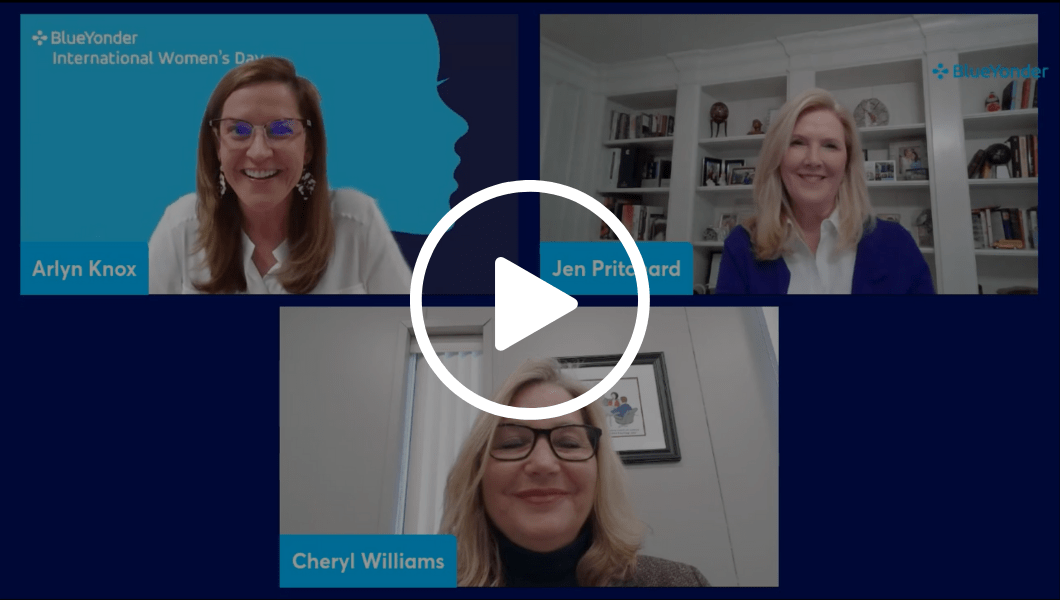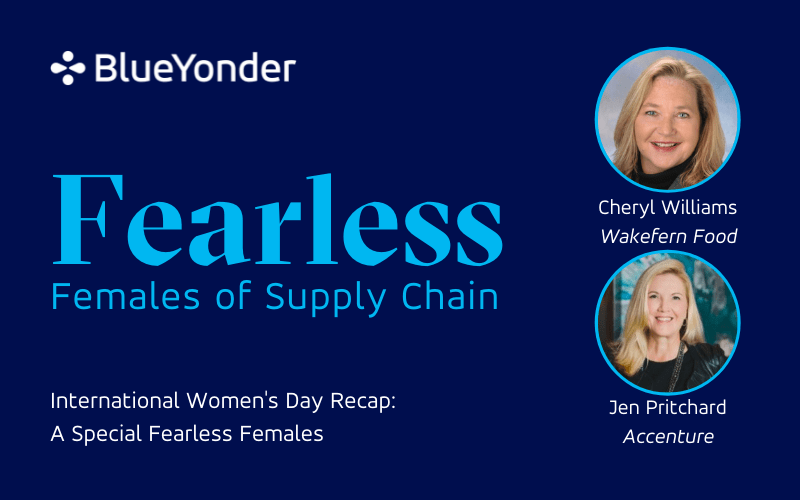Invite Others To Dance: How We Can Amplify Women and Diverse Voices
International Women’s Day is celebrated each year on March 8. This year, Blue Yonder hosted Cheryl Williams, CIO of Wakefern Food Corp., and Jen Pritchard, General Manager at Accenture, to talk about topics of importance to women in supply chain. As we close out this year’s Women’s History Month, we wanted to share their conversation with you! You can watch their conversation here.

Why do you think there is a big gender gap particularly in supply chain technology careers? Is there anything we can do to change that?
Cheryl: As I think back from a career standpoint, technology has always been a great avenue for me to pursue because it allowed me to be in a high-paying field with a lot of flexibility – and to also be a mom. I struggle with why more women are not in this field. Based on some research I found, it seems that in the mid-1980s about 40% of the technology graduates were women but that has significantly declined over the last 20 years. I can see that in my own workforce. One thing could be that there’s probably a lack of a role models in the field. I also read a study that highlighted a lot of entry courses in college curriculum are designed to weed people out – and women tend to leave this field when they feel unwanted; they will opt out quicker than men. Also, women don’t necessarily assimilate to some of the qualities that you need to be in the tech field. It is a really complex question and I think the biggest thing that we can do is educate and provide role models, as well as share all the benefits of being a working mom and being in technology.
Jen: I couldn’t agree more with Cheryl on this. I also think that we need to really share more of the amazing stories that female leaders are doing in the tech and supply chain space. Women sometimes don’t think it is an exciting place because it’s been primarily dominated by men and they don’t have the opportunity to really see the great impact that women are having in the world of smarter agriculture, smarter stores, and building greater customer experiences. All those things come from the ability to really live and breathe and be in the depths of driving technology innovation. On my global team we had a town hall for International Women’s Day. About 40% of my global team are women and we had 10 women who lead the meeting. But what struck me is that we never see these women and they don’t usually show up in a lot of our team meetings. We have to change that; we need to show up with a diverse face – and it really starts with us as leaders.
What are biggest obstacles to get to that diversified workplace?
Jen: The data has shown that there’s been a drastic impact from the COVID-19 pandemic on women in the workforce. They are exhausted and burned out because there is an increased burden; they have had to carry being the teacher, the superintendent and the CEO of home, as well as other things like elder care. I think that has had a huge impact. If you look at the data, 1 in 3 women are considering or have already left the workforce due to burnout. One of the biggest obstacles I see is feeling acceptance and respect for our ideas in the workplace. Sometimes it is so hard to even be heard as a woman. Second, I think it’s just being seen. We need to show up with more diversity on the front lines as not only diverse candidates and leadership, but we need to also be asking ourselves on our leadership teams does this actually look like me and if not, then why not. And thirdly, there needs to be much more listening and active participation by women and men alike in this. We are seeing women rise in the ranks, but we are seeing many opt out as they start to rise because they are being asked to dedicate so much time to DE&I initiatives along with all of their other responsibilities. It’s not just a woman issue, it has to be men and women alike taking up that cloak of diversity and really driving that. Accountability is really a shared responsibility.
Cheryl: You’ve got to be deliberate about it. When I first became CIO, I looked around and I looked at the management team and there was one woman manager. As we recruited for additional managers I explicitly said to HR, “You need to bring me diverse talent and that includes women.” Of course I wanted to hire the best person for the job but I had to be deliberate about asking for that talent. We have a technology leadership training program and very few women enroll. So we had to be deliberate about asking to bring more diverse talent and women into the mix so that you make sure that you have a diverse workforce that represents your customer base. During an International Women’s Day seminar and we had a guest speaker who said something really interesting: “Walk into a meeting, look around the room and if it’s not diverse then the meeting should be canceled and walk out.” And it just struck me because I thought about the first meeting I went to that morning and I was the only woman there.
What does diversity and inclusion mean to you, both personally and professionally?
Cheryl: As we develop our DE&I initiatives, what has stuck in my head is something someone said to me: “Diversity is being asked to the dance and inclusion is being invited to dance.” To me, it’s not so much about diversity it’s more about inclusion and how do you include everyone. Whether it’s making sure women and diverse voices are heard, it’s all about everybody bringing a different perspective and background and asking how we make sure they all feel comfortable in the workplace and are included in all decisions. So often you sit in a room, a woman will say something and then a man will say the exact same thing and people will think his is the great idea.
Jen: I concur with Cheryl especially the ability to not only be seen but to be heard and to influence. Diversity to me means my voice is heard and it’s valued. I’m not only invited to have a seat at the table but I can influence the outcomes. The one twist for me personally and professionally is that I don’t want to be a number. I don’t think any one of us wants to be a metric on a spreadsheet. We want to be invited to the table, but we want to also be able to influence and drive outcomes so that’s really important.
What advice would you give to someone looking to get into the supply chain field? What would you like them to do? How can they advocate for themselves? What do you think would be a good path?
Cheryl: If you want to get into any of the STEM fields, including supply chain and technology, you just have to do it! Don’t be deterred. If it’s something that you are passionate about, find a route to do it. If you are looking at a certain curriculum and it doesn’t fit your mindset go look at another curriculum at a different school. Get involved through internships. Also, reach out and talk to people working in the field.
Jen: I would say network with your tribe. Often we don’t take advantage of the people that are in our network because we don’t want to ask for help. I say ask for help! Ask to be introduced because your network is the strongest thing that you will develop, and it is worth a lot of money so spend the time there. The second is to follow your passion. It might take you a while to find what the right job within technology is for you, but stick with it. The last, and most important, thing is your career is not a straight line; it is a highway with a lot of on-ramps and off-ramps so be a continual learner. If you stop learning you get really bored. Your career is long but it can be very, very enjoyable.

